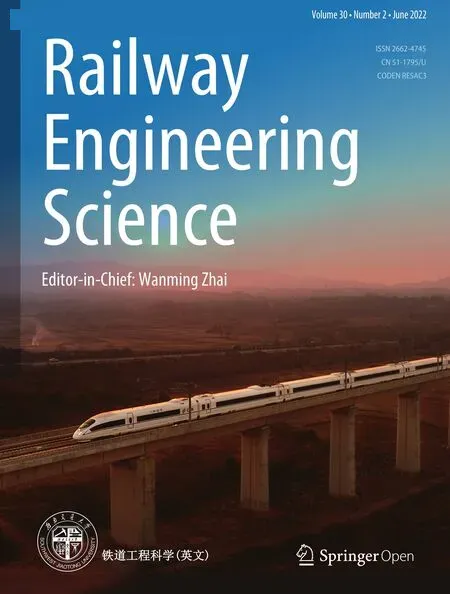Railway Engineering Science
(Quarterly,Started in 1993)
Volume 30,Number 2,June 2022
ISSN 2662-4745 (print version)
ISSN 2662-4753 (electronic version) CN 51-1795/U
Publication Information
Administrated by:Ministry of Education of the People’s Republic of China
Sponsored by:Southwest Jiaotong University
Edited &Published by:The Editorial Board ofRailway Engineering Science
Editor-in-Chief:Prof.Wanming Zhai
Editorial office:Room 453,Administrative Building,Xipu Campus,Southwest Jiaotong University,Chengdu 611756,China,E-mail:res@swjtu.edu.cn,Tel.:+86-28-66366847,66366552
Printed by:Chengdu Qinde Designing &Print Co.,Ltd.
Distributed by:Chengdu Post Office in China and Springer Nature outside China
Subscription Information
Domestic subscription:All local post offices in China (subscription code:62-40,annual subscription price:RMB ¥200.00).
Overseas subscription:Springer Nature Customer Service Center Journals,Tiergartenstr.15,69121 Heidelberg,Germany,E-mail:subscriptions@springer.com,or 233 Spring Street,New York,NY 10013-1578,USA,E-mail:journals-ny@ springer.com.
Copyright and License Agreement
For copyright regulations and license agreement,please go to www.springeropen.com/about/copyright.
Open AccessThe articles published in this journal are distributed under the terms of the Creative Commons Attribution License which permits any use,distribution,and reproduction in any medium,provided the original author(s) and source are credited.
Copyright of articles:
© The Author(s) 2022
Publication FeeAuthors are not subjected to color charges or Open Access charges.
Instructions forAuthors are available at www.springer.com/40534
Online Manuscript Submission
Railway Engineering Sciencehas a fully web-enabled manuscript submission and peer-review system with easy log-in tracking procedures available at www.editorialmanager.com/jmtr.
Further articlescan be found at link.springer.com.
Aims and Scope
Railway Engineering Science is an international,peerreviewed,and free open-access journal that publishes original research articles and comprehensive reviews related to fundamental engineering science and emerging technologies in rail transit systems,focusing on the cutting-edge research in high-speed railway,heavy-haul railway,urban rail transit,maglev system,hyperloop transportation,etc.The main goal of the journal is to maintain high quality of publications,serving as a medium for railway academia and industry to exchange new ideas and share the latest achievements in scientific research,technical innovation and industrial development in railway science and engineering.The topics include but are not limited to
• Design theory and construction technology
• System dynamics and safety
• Electrification,signaling and communication
• Operation and maintenance
• System health monitoring and reliability
• Environmental impact and sustainability
• Cutting-edge technologies
The publication costs forRailway Engineering Scienceare fully covered by Southwest Jiaotong University,so authors do not need to pay any article-processing charges.
Peer Review Policy
Railway Engineering Scienceoperates a single-blind peerreview system,where the reviewers are aware of the names and affiliations of the authors,but the reviewer reports provided to authors are anonymous.Submitted manuscripts will generally be reviewed by two or more experts,who will be asked to evaluate whether the work represents a useful contribution to the field,whether the manuscript is scientifically sound and coherent,and whether or not the manuscript is sufficiently clear for publication.The Editors will reach a decision based on these reports and,where necessary,they will consult with members of the Editorial Board.
Ethics and Disclosures
• The journal is committed to maintaining the highest level of integrity in the content published.
• The journal is a member of the Committee on Publication Ethics (COPE) and subscribes to its principles on how to deal with acts of misconduct thereby committing to investigate allegations of misconduct in order to ensure the integrity of research.
• The journal may use plagiarism detection software to screen the submissions.If plagiarism is identified,the COPE guidelines on plagiarism will be followed.
 Railway Engineering Science2022年2期
Railway Engineering Science2022年2期
- Railway Engineering Science的其它文章
- Experimental investigation on vibration characteristics of the medium-low-speed maglev vehicle-turnout coupled system
- Aerodynamic characteristics of a high-speed train crossing the wake of a bridge tower from moving model experiments
- Polyurethane grouting materials with different compositionsfor the treatment of mud pumping in ballastless track subgrade beds:properties and application effect
- Dynamic characteristics of a switch and crossing on the West Coast main line in the UK
- On dynamic analysis method for large-scale train-track-substructure interaction
- Rail temperature variation under heavy haul operations
